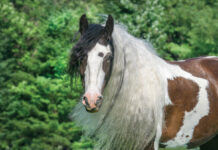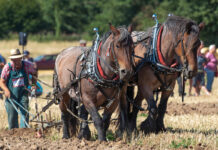When Mel Gibson galloped across the silver screen as Sir William Wallace in the Academy Award-winning film Braveheart, his beautiful bay mount was big and majestic. But in truth, the real William Wallace, a Medieval knight who defeated the English army in the First War of Scottish Independence, was carried to his victories by a rugged pony borne of the rocky Scottish Highlands.

By the time the Pict warriors battled the invading Romans, the ancestors of today’s version had become synonymous with early Scotland.
Used both for labor and for war, the small Scottish horse successfully carried riders against legions of Romans, then went back to pulling carts for this farming people after their enemies were defeated.
The harsh environment of the Highlands is thought to be responsible for the small size of the Scottish horses, which are first mentioned in travel accounts and agricultural surveys in the 18th century. By the 1830s, breeding records were being kept on these native horses, and in the 1880s, the Highland Pony studbook was established.
Also called the garron—a Gaelic word—this pony spent much of its later history as a workhorse for the crofters (small farmers), pulling carts and plows and carrying packs in the Highlands. For the past 170 years, Highland Ponies have been the main means of transporting game for hunters pursuing deer and other animals in the Highlands.

Today’s Pony
Although the Highland Pony’s ancestry is firmly rooted in a utilitarian past, the breed has adapted well to today’s competitive environment. Highland Ponies are doing well in dressage, eventing, jumping and driving, particularly in the UK. Only 120 Highland Ponies are registered in the U.S., but they number around 3,000 on the other side of the pond.
Here in North America, around 10 of these ponies are actively showing in dressage, and the breed had its first sponsored individual breed class at Dressage at Devon in 2018. These Scottish ponies are known for their versatility as well as their gentle nature.
While the breed’s numbers are still small in the U.S., they are the treasure of Scotland, and are well known throughout Great Britain. In fact, Her Majesty the Queen has a large working stud of these ponies, proving that though small, these ponies are very mighty indeed.
Highland Pony Fast Facts
- Height: 13-14.2 hands
- Color: Various duns, gray, brown, black, bay, and liver chestnut with silver mane and tail.
- Overall Appearance: Alert expression with kind eyes, broad muzzle and deep jowls. Good sloping shoulder, well-balanced and compact body with deep chest and powerful quarters.
- Associations:
Highland Pony Enthusiasts Club of America www.hpeca.org
Highland Pony Society www.highlandponysociety.com







We breed Highland and Dales ponies as well as PRE horses. We specialize in uncommon lines. Our ponies are imports from Scotland.
Trinityglen Highland Ponies, stallion, Circle H Glen Livit, is one of the photos in this article. We at Trinityglen Highland and Dartmoor ponies are active in the conservation of both the beautiful Highland Pony as well as the Dartmoor pony. Both rare breeds. We would be happy to talk to you about our beautiful ponies.?